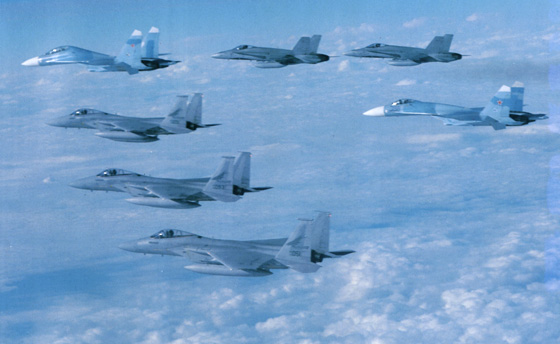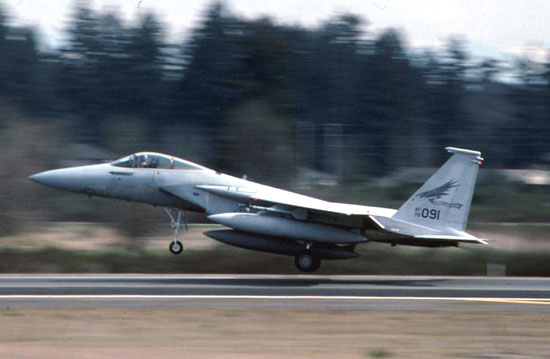|
|
 |
|
|
|
HISTORY |
|
|
 |
|
F-15A Eagles from the Det.
1, 142nd FIG and the 123rd FIS are pictured with two Canadian CF-18A
Hornets escorting two Soviet SU-27 Flankers through US airspace on their
way to a airshow in the Midwest.
|
|
|
|
Detachment 1, 142nd
Fighter Interceptor Group was established at McChord AFB on February 1,
1990. The Red Hawk assumption of the alert role came after four months
of high level meetings that delayed the Red Hawk alert by 2 months.
During this period, members of the 48th Fighter Interceptor Squadron
continued their presence that they had maintained since the closure of
318th's alert commitment at McChord.
|
|
|
|
In the meetings between
the Headquarters Tactical Air Command, Military Airlift Command,
National Guard Bureau, 1st Air Force, 62nd Military Airlift Wing
(McChord AFB host unit) three issues were resolved before the required
Host / Tenant agreement could be signed. Under the agreement, TAC would
fund MAC's (62 MAW) support of services required to support the
detachment, including the 17 security police assigned to provide
security for the alert facility. A command post once located at
facilities would be moved to the alert facility, this post would be
manned by six permanent ANG personnel.
|
|
|
 |
|
An F-15A Eagle Det 1, 142nd
FIG is marshaled in to a McChord AFB "alert barn" in the early 90's.
|
|
|
|
On February 1, 1990 at
exactly 0001 hours the first two aircrew with their F-15A's and 25 other
support crew began operations for the North American Aerospace Defense
Commands (NORAD) 5 minute / 24 hour alert commitment once crewed by
members of the 318th FIS. The detachment would be commanded by Major
(Lt. Col. select) Billy Cox.
|
|
|
|
The first pilots to
stand alert, Major Larry Kemp and Capt. Mark Ketleson flew the two
former "Green Dragon F-15's (one being F-15A 76-0073) from Portland to
McChord.
|
|
|
|
Members were of the
Det. were a part of a historic event that would have had a much
different outcome during the Cold War. On June 19, 1990 F-15's from Det.
1, 142 FIG escorted two Soviet SU-27 Flankers to an airshow at Paine
Field WA, the unit would also provide ground support to their former
advisories. Ironically, this Cold War peace would contribute to the end
of the McChord Alert commitment.
|
|
|
 |
|
PHOTO BY PLANEPHOTOMAN-FLICKR |
|
Former 318th FIS F-15A, s/n
76-0091 returns to McChord during a 142nd FIG
Operational Readiness Inspection.
|
|
|
|
As a part of the
Department of Defense force reduction plan Det. 1, 142 FIG & along with
the McChord AFB alert commitment would cease on September 30, 1993. This
change would directly affect the personnel of the 123rd FIS / 142nd FIG,
eliminating the 25 full time military positions and 4 pilot slots. The
home base alert commitment at Portland would not change. Reductions of
the Easter Bloc military threat not only lead to the deactivation of the
alert commitment in Washington State, it also caused the deactivation of
sites in Vermont, Michigan, and North Carolina.
|
|
|
|
As a "cold site", the
McChord alert barns would host fighters on a few occasions over the next
years including a return during the early stages of Operation Noble
Eagle, the effort to protect the skies over America
after the September 11 attacks.
After the terrorist attacks on
the World Trade Center complex in New York, members of the Oregon Air
National Guard would man fully armed F-15s on runway alert from their
Portland base, fly combat air patrols over selected cities in the
Northwest, and later, organize a detachment of "Alert Birds" at McChord
AFB. This detachment of Eagles would once again return home after few
years at the Tacoma area base.
|
|
|
 |
|
A member of the 142nd
Fighter Wing prepares one of the Wings F-15As at McChord AFB during
Operation Noble Eagle.
|
|
|
|
|
 |